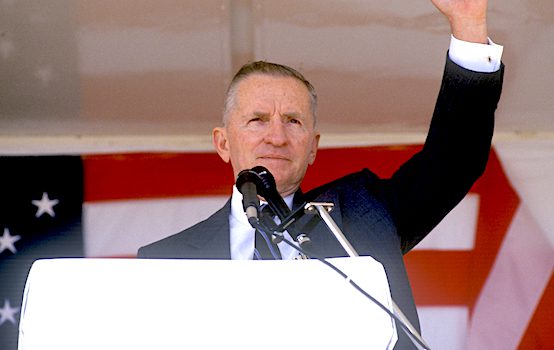The Return of the Populist Deficit Hawk
Donald Trump has some fine political models to draw on if he’s serious about fiscal responsibility. The post The Return of the Populist Deficit Hawk appeared first on The American Conservative.

The Return of the Populist Deficit Hawk
Donald Trump has some fine political models to draw on if he’s serious about fiscal responsibility.

Ross Perot was in many ways a precursor to President-elect Donald Trump. Perot was viewed as a credible presidential candidate despite never having previously held or even run for office because of his vast business holdings and management experience. Perot even promised to run the federal government like a business, promising a less “adversarial” and more “intelligent” relationship between government and business.
Despite his considerable wealth, Perot campaigned as a populist in the tradition of William Jennings Bryan. The Texas billionaire warned of the “giant sucking sound” jobs would make after they flowed out of the United States in the wake of a free-trade agreement with Mexico. Perot wanted to curtail illegal immigration. He wanted an interventionist bipartisan establishment to turn its focus inward, saying his “highest foreign policy priority is to get our house in order and make America work again.”
There are two major differences between Trump and Perot. The first, and most obvious, is that while Perot ran as an independent in 1992 and tried to start a lasting third-party movement as the Reform Party presidential nominee in 1996, Trump has conducted a—some would say hostile—takeover of the Republican Party. Trump was the Republican nominee in three straight presidential elections, winning two of them.
The second is the centrality of the federal budget deficit as a Perot campaign issue. Conservatives were starting to debate the old Reaganite consensus on trade, immigration, and foreign policy as both the Cold War and Ronald Reagan’s chosen successor’s first term came to an end. But the deficit and national debt were ballooning after 12 years of Republican administrations. If there was one area where these presidents had violated the Reaganite consensus itself, it was the deficit.
This led to both populist and centrist revolts against the GOP by 1992. Paul Tsongas ran on a platform of deficit reduction and fiscal responsibility in the Democratic primaries, while being a conventional liberal in other respects (some Democrats feared at that time growing interest payments on the debt would eventually crowd out spending on social welfare programs). Jerry Brown ran to Bill Clinton’s populist left, but sought to impose a 13 percent flat tax. Pat Buchanan ran to George H.W. Bush’s right on both taxes (the 41st president had broken his 1988 “read my lips” pledge against raising taxes) and spending in the Republican primaries.
Trump has at times criticized how the federal government mismanages money, especially under the leadership of his Democratic opponents. He has at times made vague promises to cut that spending and appointed strong fiscal conservatives to oversee the budgetary process within his own administrations. Mick Mulvaney was hailed as the “most fiscally conservative budget director in decades” in 2017 and Russ Vought boasts a similar reputation now. Some Republican lawmakers had hoped for a renewed focus on fiscal discipline in a second Trump term, whether that took place four years ago or now.
But overall, Trump hasn’t been a true believer in balanced budgets. He won in 2016 and 2024 in part because he largely eschewed Paul Ryan-style entitlement reforms. He has vowed not to cut Social Security or Medicare, which will make it difficult for him to get a handle on two of the biggest drivers of long-term debt. While he sought to repeal Obamacare in his first term, there was never a guarantee he would back a more austere replacement and is now noncommittal about repeal as his second term approaches.
Under Trump, like most recent Republican presidents, there have been more tax cuts than spending cuts. This year, Trump ran on tax cuts that were less geared to upper income earners, such as no taxes on tips, but also less likely to recoup lost revenue by standard supply-side means. Trump presided over massive pandemic spending and deficits, largely rebuffing those who wanted to rein it all in before the lockdowns were lifted fully.
Then came DOGE. That would be the Department of Government Efficiency, a Trump task force to take on bloated federal spending and the administrative state, run by the incoming president’s top ally Elon Musk and his mini-me of the 2024 presidential primaries, Vivek Ramaswamy. While both men are difficult to classify ideologically over the fullness of time, currently the pair of entrepreneurs are arguably the two biggest techno-libertarians within Trump’s inner circle.
We have seen similar projects in the past, ranging from the Grace Commission under Reagan to Al Gore’s Reinventing Government initiative under Bill Clinton. Many of them have done good work. But Musk has said he intends to cut $2 trillion out of the gargantuan $6.75 trillion budget, reductions that would in theory go way past waste, fraud, and abuse.
“A band of small-government revolutionaries will save our nation,” Ramaswmy vowed. Musk, for his part, said he is bent on “ensuring that maniacally dedicated small-government revolutionaries join this administration.” Trump has never been much of a small-government revolutionary, maniacally dedicated or otherwise. Some would argue he has run away from that tendency of Ronald Reagan’s as much as Reagan distanced himself in much the same way from Barry Goldwater. That in turn, the argument goes, is why Reagan won in two landslides while Goldwater lost in one and Trump won the presidency 20 years after Reagan’s death.
At the same time, Trump first seriously considered a national campaign within Perot’s Reform Party in 1999. Paradoxically, Trump’s short-lived Reform campaign was part of a factional fight to prevent a Perot-Buchanan alliance from taking party leadership away from its most successful elected official, Jesse Ventura, who was then governor of Minnesota. But Trump’s mixture of moderate business Republicanism with economic nationalism seemed like a fit for Perot’s movement.
Trump’s more serious national political aspirations came during the Tea Party movement of the 2010s. While he initially represented its flirtations with hyperpartisanship and conspiracy theories (Trump was a big part of birtherism) more than its fusion of libertarianism and constitutional conservatism with populism and Middle American Radicalism, it was then that the real-estate developer–turned–reality-TV star was first regularly spoken of as a possible presidential candidate.
Before being sidetracked by Covid-19, deregulation, tax cuts, and Obamacare repeal were among the top domestic policy priorities of Trump’s first term. As he ran for a return to the White House this year, Trump openly talked about replacing the income tax with tariffs. That would imply a much smaller federal government, as existed when Washington’s ambitions were last so funded. While seeking to emulate Grover Cleveland by serving nonconsecutive presidential terms, Trump held up William McKinley as his economic model.
Trump also spoke at the 2024 Libertarian National Convention, sought their presidential nomination, and, failing that, appealed for their votes. How successful this was is hard to measure. But the actual LP presidential nominee received fewer than 1 million votes for the first time since 2008, running a distant fifth place nationally. Trump became the first Republican nominee to win the national popular vote since 2004. Ballot access played a role in this, but it stands to reason that Trump got a large share of Libertarian—to say nothing of libertarian—votes as part of a broader anti-establishment coalition that also includes ex-Democrats like Robert F. Kennedy Jr. and Tulsi Gabbard.
Most importantly, Trump won the election in no small part due to inflation hitting a 41-year high under President Joe Biden. While Trump is not blameless in the inflationary spending that took place since the pandemic, only Biden pushed an additional stimulus package after multiple others had already been enacted and, critically, as Americans were returning to work with the worst business closures behind them. Trump thus ran against inflationary spending practices this year and has now seen how excessive expenditures can hurt voters even without being paid for by broad-based tax increases.
Argentina’s President Javier Milei was the first international leader to appear with Trump at Mar-a-Lago after the latter’s November victory, not Hungary’s Viktor Orban. Ramaswamy and Musk could draw heavily from Milei’s example in trying to take a scalpel to the government while being animated by populism. There are other, more libertarian models for a second Trump administration to follow.
There are less libertarian ones too, and closer to home. Perot may have run long informercials showing charts about deficit spending and the national debt, a way around the mainstream media and nightly news before podcasts existed or the internet was widespread, but he was a deficit hawk, but not really a libertarian.
Perot at times championed a more ambitious national health insurance program even as he promised to wipe away Washington’s red ink. Like Musk, he had made some of his billions from government contracts. He wanted to get the debt and deficits under control, but he was no small-government revolutionary himself. He was willing to rely on tax increases as well as spending cuts, and not all his cuts were targeted at popular social welfare programs.
Unlike Trump, however, Perot never had to actually govern. In fact, he never needed to appeal to an electoral coalition that drew more than 19 percent of the vote. But he had an impact on both parties, some of which can still be felt with Trump. And Trump is constitutionally ineligible to seek another term in 2028, giving him the luxury of making tough choices that eluded him from to 2017 to 2021 and have posed a problem for many of his predecessors.
Yet Trump has faced harsh criticism when he has deviated from his more government-friendly populism in the past. The Heritage Foundation’s Project 2025 was a major Democratic target throughout the presidential campaign. Democrats from Biden to Vice President Kamala Harris campaigned as if Trump was lying about not wanting to cut Social Security or Medicare.
“We have a nominee whose ideology is in direct contrast to what President Trump ran on. President Trump told working people and seniors he would not cut Social Security, Medicare and Medicaid,” Sen. Bernie Sanders said in 2017, when Mulvaney was tapped as budget director. “Yet you have a nominee who prides himself, who is a deficit hawk, who has said over and over again that he will do exactly the opposite of what President Trump campaigned on.”
Sanders had offered to work with Trump on infrastructure and other projects back then. He has floated collaborating with Trump on capping credit card interest rates this time around. But he will surely be open to campaigning against Musk and Ramaswamy instead.
It’s no accident that Musk and Ramaswamy were not chosen for jobs that require Senate confirmation, a risk Trump was briefly even willing to take for Matt Gaetz. DOGE, notwithstanding its official-sounding name, is not a real Cabinet-level department and requires no act of Congress to create.
Spending cuts of any size could always stunt Trump’s political momentum, as budget fights have done for Republicans before. But there is a basic arithmetic that cannot be denied forever. And Trump has the opportunity to keep rebuilding the GOP coalition.
The federal budget is now bigger than the national debt was when Perot started running on the issue. The deficit is bigger than the federal budget was when Perot first began warning it was unsustainable. Can DOGE, created by an actual populist president, finally deliver on the promises of the old Perot campaigns?
The post The Return of the Populist Deficit Hawk appeared first on The American Conservative.
What's Your Reaction?















